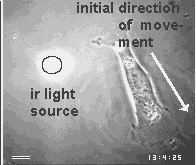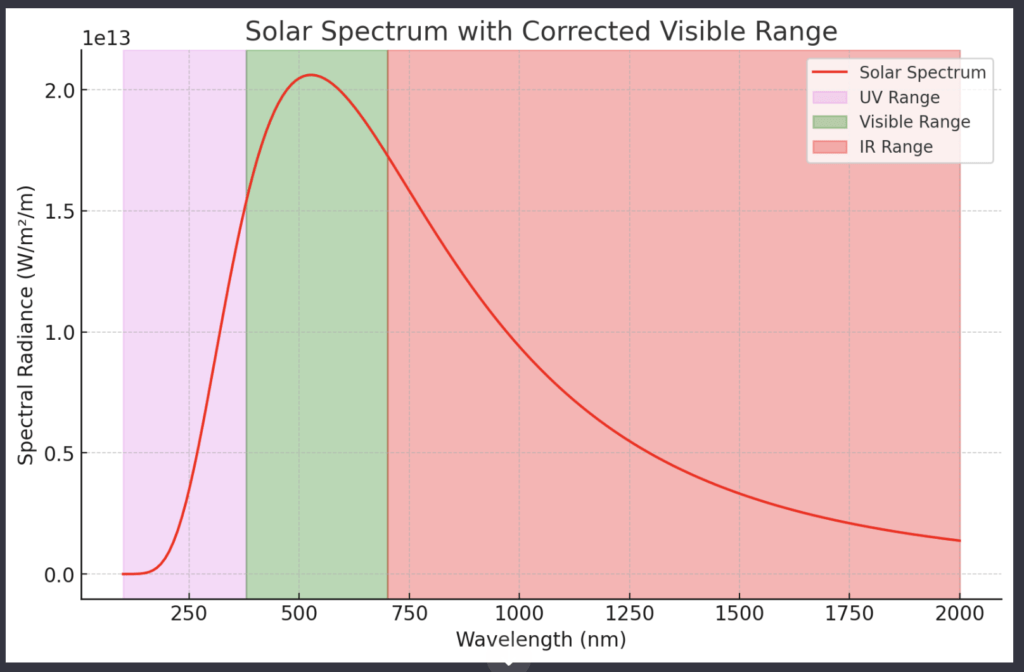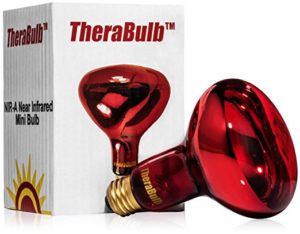Near Infrared Therapy (NIR) enhances cell function and the function of the extracellular matrix in many different ways. NIR is widely used as a cosmetic treatment for regenerating collagen and elastin under the skin. Collagen and elastin are primary constituents of the connective tissue matrix which underly both posture and movement. Here is an image of mitochondria activated by an infrared light source:

Early research on NIR therapy was done by the National Aeronautics and Space Administration (NASA early 1960s) after it was realized that our bodies need gravity to manage inflammation. NASA researchers found that the NIR band of energy penetrates deeply into the body (both soft tissue and bone), with regenerative cellular responses, including an increase in cellular metabolism, protein synthesis (including collagen), anti-oxidant activity, increased vascular function, reduced inflammation and pain. A search of research literature will uncover thousands of papers spanning nearly 80 years on NIR therapy such as this 2018 PubMed paper: AGING IS A STICKY BUSINESS.
I have many years of experience using NIR tools and constantly rely on them to:
- increase the rate of healing from injuries (strains, sprains, and wounds)
- reduce inflammation
- eliminate joint pain
- soften old scar tissue
- increase range of motion
To get started with NIR I suggest an old-school incandescent NIR lamp. The one I like the best is from Therabulb:
WWW.THERBULB.COM
I recommend these over the many LED-type offerings as the LED devices, although effective, are outranked in efficacy by this original offering. The main drawback is finding a suitable holder. A painter’s clamp on a heat lamp base is often used. The base and lamp can be had for <$40.00
Treatment Recommendation:
Less than 10 minutes on any one spot, up to three or four times per day.
I have seen studies demonstrating that the efficacy of treatment tapers off after about 7 minutes.
The lamp should be at a distance where it feels just comfortably warm (the bulb runs hot enough to burn, but not nearly as hot as you might expect).
If you are treating an injury, it can be very helpful to treat the tissues that are not injured, but associated with the injury (ie: in treating a knee, also expose the thigh, calf, and foot).
If you find that NIR is helpful, the next step is to invest in an NIR Laser wand, which runs several hundred dollars. These are often called “Cold Lasers” as they do not generate heat but deliver coherent beams of NIR light deep into the body. I do not have a manufacturer recommendation here as these come from China, but you might find a distributor for this wand, which I have had good luck with. Because they use a multitude of lasers, there are minor phase and interference issues.
I am currently working with a high-intensity single-beam 850 nm laser that pumps a truly coherent, phase-aligned beam of electromagnetic energy. I find this to be by far the most efficacious NIR therapy I have encountered. My subjective experience is that treatment times per spot are about 60 seconds.
I am interested in developing this as a clinical tool and have completed the basic design work. Parts costs are very high and it would likely be in the $900.00- $1200.00 range, limiting the project’s viability. It is also, in my opinion, a very cool coffee table project.
Using NIR in conjunction with Manual Therapy has been very productive, significantly increasing the rate of treatment, and decreasing the required effort.
WHAT IS NEAR INFRARED THERAPY – A SHORT ESSAY
Near-infrared (NIR) therapy is a type of light therapy that uses light with a wavelength of 700 to 1000 nanometers. NIR light is invisible to the human eye, but it can be felt as heat. NIR therapy has been shown to have several beneficial effects on the body, including reducing inflammation, improving wound healing, and increasing joint function.
NIR therapy works by stimulating the production of ATP, the body’s main source of energy. ATP is needed for cell growth and repair, so increased ATP production can lead to increased fibroblast activity. Fibroblasts are cells that produce collagen, a protein that is essential for the strength and flexibility of the skin, bones, and other tissues.
In addition to increasing the activity of fibroblasts, NIR therapy can also help to reduce inflammation and pain. This is because NIR therapy can increase the production of nitric oxide, a molecule that has anti-inflammatory and pain-relieving properties.
NIR therapy is effective in treating a variety of conditions, including:
- Wound healing: NIR therapy can help speed up the healing of wounds by increasing the production of collagen and other proteins that are needed for wound repair.
- Arthritis: NIR therapy can help reduce pain and inflammation in people with arthritis by increasing the production of nitric oxide.
- Rheumatoid arthritis: NIR therapy can help to improve joint function and reduce pain in people with rheumatoid arthritis by increasing the production of collagen and other proteins that are needed for joint repair.
- Fibromyalgia: NIR therapy can help to reduce pain and improve sleep quality in people with fibromyalgia by reducing inflammation and increasing the production of ATP.
NIR therapy is a safe and effective treatment for many conditions, but it is important to talk to your doctor first. NIR therapy is not a cure for all pain, and it may not be appropriate for everyone.
Here is a more detailed look at how NIR therapy can benefit joint function, wound healing, and hyaluronic acid production:
Joint function: NIR therapy can help to improve joint function by increasing the production of collagen and other proteins that are needed for joint repair. NIR therapy can also help to reduce inflammation and pain, which can make it easier to move and use your joints.
Wound healing: NIR therapy can help speed up the healing of wounds by increasing the production of collagen and other proteins that are needed for wound repair. NIR therapy can also help reduce inflammation and pain, which can make it easier for wounds to heal.
Hyaluronic acid: Hyaluronic acid is a type of sugar found in the body. It is a major component of the extracellular matrix, which is the material that surrounds cells and tissues. Hyaluronic acid helps to keep joints lubricated and cushioned, and it also helps to promote wound healing. NIR therapy can help to increase the production of hyaluronic acid, which can lead to improved joint function and wound healing.
In addition to the benefits mentioned above, NIR therapy has also been shown to be effective in reducing free radical damage, increasing growth factor production, and improving mitochondrial function. Free radicals are unstable molecules that can damage cells. Growth factors are proteins that promote cell growth and repair. Mitochondria are the cells’ “powerhouses,” and they produce ATP. By reducing free radical damage, increasing growth factor production, and improving mitochondrial function, NIR therapy can help to improve overall health and well-being.
NIR therapy is a safe and effective treatment for a variety of conditions. It is a non-invasive treatment that does not require surgery or medication. NIR therapy is also relatively inexpensive, making it a cost-effective option for many people.
If you are considering NIR therapy, it is important to talk to your doctor first. NIR therapy is not a cure for all pain, and it may not be appropriate for everyone. However, for those who can benefit from NIR therapy, it can be a safe and effective way to improve their health and well-being.
TRADITIONAL USES OF NIR
Infrared Therapy has a long tradition in Traditional Medicine. One example is the use of Moxa to treat inflammation and wound healing. Moxa’s origins predate the documentation of traditional medical practices. Another is the Sweat Lodge, where one sits facing hot rocks that are emitting powerfully in the infrared frequencies.
There is an Infrared therapeutic appliance often used in conjunction with Traditional Chinese Medicine called a MIneral Heat Lamp, that emits infrared in the spectra of the elements our bodies utilize, similar to the rocks in a Sweat Lodge, but more specifically directed. There is significant validation of the therapeutic efficacy of this tool. These modalities utilize a broad spectrum of infrared light frequencies and are sometimes described as Far Infrared Therapies.
THE POWER SPECTRA OF SUNLIGHT
Approximately 50% of the total power of the Sun’s spectra is in the Infrared (IR) range.
This calculation is based on the integration of the spectral radiance over the IR wavelength range, compared to the total spectral radiance across the entire spectrum.
This is light that our ancestors and other land animals are habituated to being exposed to.
Our built surroundings do not waste energy illuminating in the infrared. This is especially true with the advent of LED lighting which minimally wastes energy as heat.
Consequently, we are NIR starved.
This has a good probability of explaining the efficacy of NIR therapy – simply by replacing a component of natural light that we evolved to utilize, but often no longer have easy access to.





